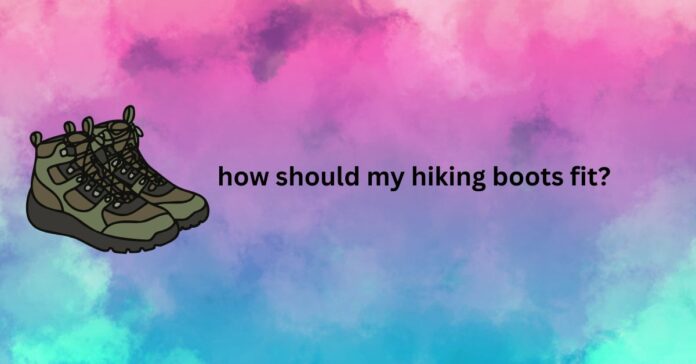Discover the essential considerations for achieving the perfect fit with your hiking boots. Learn how to optimize your comfort, prevent discomfort and blisters, and enhance your overall hiking experience. Dive into this comprehensive guide and master the art of finding the right fit for your hiking boots.
Embarking on a hiking adventure is an exhilarating experience, but it requires the right footwear to ensure a successful and enjoyable journey. Hiking boots are purpose-built to provide support, traction, and protection on rugged terrains, making them an indispensable gear item for outdoor enthusiasts. However, simply purchasing a pair of boots is not enough; you must strive for the perfect fit to unlock their full potential. In this in-depth guide, we will explore everything you need to know about how your hiking boots should fit to optimize your comfort, boost your performance, and elevate your overall hiking experience.
The Importance of Proper Fit:
A proper fit for your hiking boots is more than just a matter of comfort; it directly impacts your performance and safety on the trails. Here are some key reasons why achieving the perfect fit is essential:
- Support and Stability: Hiking boots that fit well provide crucial support to your ankles and feet, reducing the risk of sprains and twists. Whether you’re navigating steep ascents or traversing rocky terrains, proper support enhances your stability, allowing you to confidently conquer the trails.
- Preventing Blisters and Discomfort: Ill-fitting boots can lead to painful blisters, hotspots, and discomfort. When your boots fit correctly, there is minimal friction and pressure on your feet, significantly reducing the likelihood of these issues. Say goodbye to those painful distractions and focus on the beauty of nature around you.
- Injury Prevention: Wearing boots that are too loose or too tight can increase the risk of various foot and leg injuries. A proper fit promotes proper alignment, reducing the chances of conditions such as tendonitis, plantar fasciitis, and stress fractures. Invest in the right fit now to prevent long-term consequences.
Key Factors to Consider
To ensure the perfect fit, keep the following factors in mind while trying on hiking boots:
- Toe Box and Wiggle Room: The toe box should offer ample space for your toes to move freely. Wiggle your toes inside the boot to ensure there is sufficient room. This prevents discomfort and potential toenail issues during long hikes, allowing your toes to feel happy and unrestricted.
- Heel Hold and Lockdown: A snug, secure fit around the heel is vital to prevent blisters and ensure stability, especially during descents. Your heel should be comfortably cradled, minimizing excessive slippage and keeping you firmly grounded on the trails.
- Arch Support and Footbeds: Look for boots that offer proper arch support, as it helps distribute your weight evenly and align your foot’s natural shape. Additionally, consider using custom or aftermarket footbeds to enhance comfort and provide additional support if needed. Happy arches mean happy hikes.
- Width and Sizing Considerations: Each foot is unique, so finding the right width and size is crucial. Pay attention to your foot’s width and any specific sizing recommendations from the boot manufacturer. Try on boots with hiking socks to ensure a proper fit, as thicker socks are commonly worn during hikes for added comfort and moisture management.
Conclusion
Finding the perfect fit for your hiking boots is a fundamental step towards maximizing your outdoor adventures. By considering factors such as toe box space, heel hold, arch support, and width, you can ensure optimal comfort, support, and injury prevention. Don’t rush the process; take the time to find the boots that fit you like a glove. Remember, a well-fitting pair of hiking boots is your ticket to unforgettable experiences, allowing you to fully immerse yourself in the wonders of nature while keeping your feet happy and protected. Get ready to embark on your next hiking adventure with confidence, knowing that your boots are a perfect fit for the journey ahead.
FAQs
- How much wiggle room should I have in the toe box? In the toe box, you should have enough room to wiggle your toes comfortably. Aim for about a thumbnail’s width of space between your longest toe and the front of the boot. This allows for natural movement, prevents cramped toes, and reduces the risk of blisters.
- Should hiking boots fit tighter or looser than regular shoes? Hiking boots should fit snugly but not overly tight. They should provide a secure hold around your foot, especially in the heel area, to prevent excessive slippage. However, avoid constriction that could restrict blood circulation or cause discomfort during long hikes. Strive for a balance between a secure fit and ample comfort.
- Can I wear thicker socks with hiking boots? Yes, it is recommended to wear moisture-wicking hiking socks that provide cushioning and support. Thick socks are commonly worn during hiking to enhance comfort and moisture management. When trying on boots, wear the socks you plan to hike in to ensure an accurate fit and avoid surprises on the trail.
- How long does it take to break in hiking boots? Breaking in hiking boots can vary depending on the individual and the boots themselves. It typically takes several shorter hikes or a few weeks of regular use for the boots to mold to your feet and become more comfortable. Gradually increase the duration and difficulty of your hikes to allow your boots to adapt to your feet’s unique contours.
Remember, finding the right fit is essential for a successful and enjoyable hiking experience. If you have any specific concerns or questions, consult with a knowledgeable footwear professional for personalized guidance.


